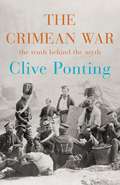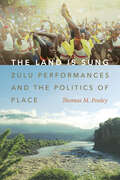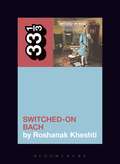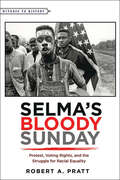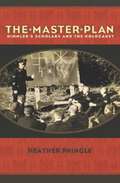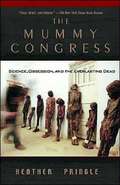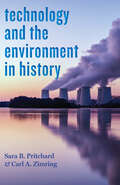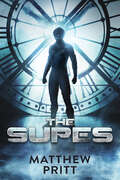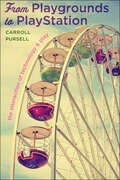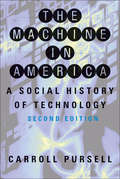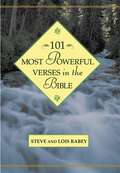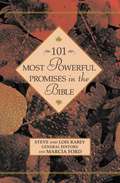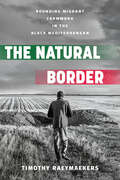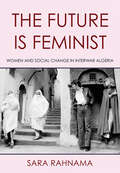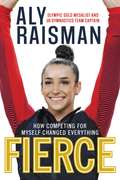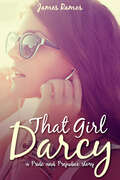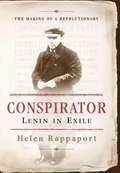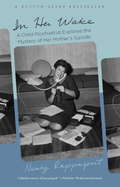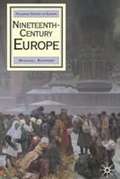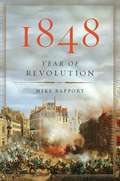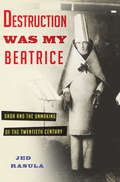- Table View
- List View
What Your Doctor May Not Tell You About(TM) (TM) (TM) (TM) (TM) (TM) (TM) (TM): Colorectal Cancer: New Tests, New Treatments, New Hope
by Mark Bennett PochapinOver 50,000 men and women die from colorectal cancer each year - a particularly alarming statistic since it is also one of the most preventable and treatable cancers. In fact, it is estimated that over one-third of colorectal cancer deaths could have been avoided. Now, there's hope. Contains important information on beating colorectal cancer, including the six biggest lifestyle threats, the three nutritional supplements anyone at risk should take, the optimal timeframe for screenings, the pros and cons of new detection tests, and how to effectively treat cancerous and pre-cancerous polyps with both traditional and alternative methods.
The Crimean War: The Truth Behind the Myth
by Clive PontingThe Crimean War is full of resonance - the battles of Alma, Balaclava and Inkerman, the Charge of the Light Brigade, the siege of Sevastopol, Florence Nightingale at Scutari with her lamp. To contemporaries, it was not the Crimean War but 'The Great War with Russia' - ironically Britain's allies were France, her traditional enemy, and the Ottoman Empire, widely seen as an infidel, corrupt Islamic power. Britain was unable fully to deploy her greatest strength, the Royal Navy, while her army was run by incompetent aristocrats. With his sharp eye and analytical mind, Clive Ponting explodes many of the romantic myths which grew up in the years following the war, while telling the true story of the heroism of ordinary men. Above all, he makes use of the testimony of eye-witness accounts, from William Russell of The Times, the first war correspondent, to Leo Tolstoy, who was caught up in the action while visiting his brother, to the memories of a variety of serving soldiers.
The Crimean War: The Truth Behind the Myth (PDF)
by Clive PontingThe Crimean War is full of resonance - the battles of Alma, Balaclava and Inkerman, the Charge of the Light Brigade, the siege of Sevastopol, Florence Nightingale at Scutari with her lamp. To contemporaries, it was not the Crimean War but 'The Great War with Russia' - ironically Britain's allies were France, her traditional enemy, and the Ottoman Empire, widely seen as an infidel, corrupt Islamic power. Britain was unable fully to deploy her greatest strength, the Royal Navy, while her army was run by incompetent aristocrats. With his sharp eye and analytical mind, Clive Ponting explodes many of the romantic myths which grew up in the years following the war, while telling the true story of the heroism of ordinary men. Above all, he makes use of the testimony of eye-witness accounts, from William Russell of The Times, the first war correspondent, to Leo Tolstoy, who was caught up in the action while visiting his brother, to the memories of a variety of serving soldiers.
The Land Is Sung: Zulu Performances and the Politics of Place (Music / Culture)
by Thomas M. PooleyWhat does it mean to belong? In The Land is Sung, musicologist Thomas M. Pooley shows how performances of song, dance, and praise poetry connect Zulu communities to their ancestral homes and genealogies. For those without land tenure in the province of KwaZulu-Nata, performances articulate a sense of place. Migrants express their allegiances through performance and spiritual relationships to land are embodied in rituals that invoke ancestral connection while advancing well-being through intergenerational communication. Engaging with justice and environmental ethics, education and indigenous knowledge systems, musical and linguistic analysis, and the ethics of recording practice, Pooley's analysis draws on genres of music and dance recorded in the midlands and borderlands of South Africa, and in Johannesburg's inner city. His detailed sound writing captures the visceral experiences of performances in everyday life. The book is richly illustrated and there is a companion website featuring both video and audio examples.
Witch Switch (Witch Wars)
by Sibéal Pounder_______________'This is a witch story like no other – and it's a blast!' – Bookseller'Brilliantly magical' – Tom Fletcher Book Club_______________The second book in the hilarious Witch Wars series for kids aged 7+, perfect for fans of The Worst Witch.Tiga Whicabim is settling in to the witchy, glitzy world of Ritzy City. Peggy is Top Witch, and Tiga is enjoying life at the Brews' house with Fluffanora. But when Fran the Fabulous Fairy visits Linden House and finds Peggy has gone – leaving behind only a note to say she is 'AWAY WITH THE FAIRIES' and has left the evil Felicity Bat in charge – the girls realise something is very wrong. And then witches all across town start to disappear. Tiga and Fluffanora set out to investigate and discover an old, unsolved Sinkville mystery that might just be the key to it all.
Selma;€™s Bloody Sunday: Protest, Voting Rights, and the Struggle for Racial Equality (Witness to History)
by Robert A. PrattOn Sunday afternoon, March 7, 1965, roughly six hundred peaceful demonstrators set out from Brown Chapel A.M.E. Church in a double-file column to march from Selma, Alabama, to the state capital of Montgomery. Leading the march were Hosea Williams of the Southern Christian Leadership Conference and John Lewis of the Student Nonviolent Coordinating Committee. Upon reaching Broad Street, the marchers turned left to cross the Edmund Pettus Bridge that spanned the Alabama River. "When we reached the crest of the bridge," recalls John Lewis, "I stopped dead still. So did Hosea. There, facing us at the bottom of the other side, stood a sea of blue-helmeted, blue-uniformed Alabama state troopers, line after line of them, dozens of battle-ready lawmen stretched from one side of U.S. Highway 80 to the other. Behind them were several dozen more armed men;¢;‚¬;€?Sheriff Clark;€™s posse;¢;‚¬;€?some on horseback, all wearing khaki clothing, many carrying clubs the size of baseball bats."The violence and horror that was about to unfold at the foot of the bridge would forever mark the day as "Bloody Sunday," one of the pivotal moments of the civil rights movement. Alabama state troopers fell on the unarmed protestors as they crossed the bridge, beating and tear gassing them. In Selma;€™s Bloody Sunday, Robert A. Pratt offers a vivid account of that infamous day and the indelible triumph of black and white protest over white resistance. He explores how the march itself;¢;‚¬;€?and the 1965 Voting Rights Act that followed;¢;‚¬;€?represented a reaffirmation of the nation;€™s centuries-old declaration of universal equality and the fulfillment of the Fifteenth Amendment to the Constitution.Selma;€™s Bloody Sunday offers a fresh interpretation of the ongoing struggle by African Americans to participate freely in America;€™s electoral democracy. Jumping forward to the present day, Pratt uses the march as a lens through which to examine disturbing recent debates concerning who should, and who should not, be allowed to vote. Drawing on archival materials, secondary sources, and eyewitness accounts of the brave men and women who marched, this gripping account offers a brief and nuanced narrative of this critical phase of the black freedom struggle.
Selma;€™s Bloody Sunday: Protest, Voting Rights, and the Struggle for Racial Equality (Witness to History)
by Robert A. PrattOn Sunday afternoon, March 7, 1965, roughly six hundred peaceful demonstrators set out from Brown Chapel A.M.E. Church in a double-file column to march from Selma, Alabama, to the state capital of Montgomery. Leading the march were Hosea Williams of the Southern Christian Leadership Conference and John Lewis of the Student Nonviolent Coordinating Committee. Upon reaching Broad Street, the marchers turned left to cross the Edmund Pettus Bridge that spanned the Alabama River. "When we reached the crest of the bridge," recalls John Lewis, "I stopped dead still. So did Hosea. There, facing us at the bottom of the other side, stood a sea of blue-helmeted, blue-uniformed Alabama state troopers, line after line of them, dozens of battle-ready lawmen stretched from one side of U.S. Highway 80 to the other. Behind them were several dozen more armed men;¢;‚¬;€?Sheriff Clark;€™s posse;¢;‚¬;€?some on horseback, all wearing khaki clothing, many carrying clubs the size of baseball bats."The violence and horror that was about to unfold at the foot of the bridge would forever mark the day as "Bloody Sunday," one of the pivotal moments of the civil rights movement. Alabama state troopers fell on the unarmed protestors as they crossed the bridge, beating and tear gassing them. In Selma;€™s Bloody Sunday, Robert A. Pratt offers a vivid account of that infamous day and the indelible triumph of black and white protest over white resistance. He explores how the march itself;¢;‚¬;€?and the 1965 Voting Rights Act that followed;¢;‚¬;€?represented a reaffirmation of the nation;€™s centuries-old declaration of universal equality and the fulfillment of the Fifteenth Amendment to the Constitution.Selma;€™s Bloody Sunday offers a fresh interpretation of the ongoing struggle by African Americans to participate freely in America;€™s electoral democracy. Jumping forward to the present day, Pratt uses the march as a lens through which to examine disturbing recent debates concerning who should, and who should not, be allowed to vote. Drawing on archival materials, secondary sources, and eyewitness accounts of the brave men and women who marched, this gripping account offers a brief and nuanced narrative of this critical phase of the black freedom struggle.
The Master Plan: Himmler's Scholars and the Holocaust
by Heather PringleA groundbreaking history of the Nazi research institute whose work helped lead to the extermination of millionsIn 1935, Heinrich Himmler established a Nazi research institute called The Ahnenerbe, whose mission was to send teams of scholars around the world to search for proof of Ancient Aryan conquests. But history was not their most important focus. Rather, the Ahnenerbe was an essential part of Himmler's master plan for the Final Solution. The findings of the institute were used to convince armies of SS men that they were entitled to slaughter Jews and other groups. And Himmler also hoped to use the research as a blueprint for the breeding of a new Europe in a racially purer mold.The Master Plan is a groundbreaking exposé of the work of German scientists and scholars who allowed their research to be warped to justify extermination, and who directly participated in the slaughter--many of whom resumed their academic positions at war's end. It is based on Heather Pringle's extensive original research, including previously ignored archival material and unpublished photographs, and interviews with living members of the institute and their survivors.A sweeping history told with the drama of fiction, The Master Plan is at once horrifying, transfixing, and monumentally important to our comprehension of how something as unimaginable as the Holocaust could have progressed from fantasy to reality.
The Mummy Congress: Science, Obsession, and the Everlasting Dead
by Heather PringleMummies, experts, and breaking science revealed in journalist Pringle's fascinating dive into a little-known arena of human studies.Perhaps the most eccentric of all scientific meetings, the World Congress on Mummy Studies brings together mummy experts from all over the globe and airs their latest findings. Who are these scientists, and what draws them to this morbid yet captivating field? The Mummy Congress, written by acclaimed science journalist Heather Pringle, examines not just the world of mummies, but also the people obsessed with them.
Technology and the Environment in History: Nature and Technology in History (Technology in Motion)
by Sara B. Pritchard Carl A. ZimringToday's scientists, policymakers, and citizens are all confronted by numerous dilemmas at the nexus of technology and the environment. Every day seems to bring new worries about the dangers posed by carcinogens, "superbugs," energy crises, invasive species, genetically modified organisms, groundwater contamination, failing infrastructure, and other troubling issues. In Technology and the Environment in History, Sara B. Pritchard and Carl A. Zimring adopt an analytical approach to explore current research at the intersection of environmental history and the history of technology—an emerging field known as envirotech. Technology and the Environment in History They discuss the important topics, historical processes, and scholarly concerns that have emerged from recent work in thinking about envirotech. Each chapter focuses on a different urgent topic: • Food and Food Systems: How humans have manipulated organisms and ecosystems to produce nutrients for societies throughout history.• Industrialization: How environmental processes have constrained industrialization and required shifts in the relationships between human and nonhuman nature.• Discards: What we can learn from the multifaceted forms, complex histories, and unexpected possibilities of waste.• Disasters: How disaster, which the authors argue is common in the industrialized world, exposes the fallacy of tidy divisions among nature, technology, and society.• Body: How bodies reveal the porous boundaries among technology, the environment, and the human.• Sensescapes: How environmental and technological change have reshaped humans' (and potentially nonhumans') sensory experiences over time.Using five concepts to understand the historical relationships between technology and the environment—porosity, systems, hybridity, biopolitics, and environmental justice—Pritchard and Zimring propose a chronology of key processes, moments, and periodization in the history of technology and the environment. Ultimately, they assert, envirotechnical perspectives help us engage with the surrounding world in ways that are, we hope, more sustainable and just for both humanity and the planet. Aimed at students and scholars new to environmental history, the history of technology, and their nexus, this impressive synthesis looks outward and forward—identifying promising areas in more formative stages of intellectual development and current synergies with related areas that have emerged in the past few years, including environmental anthropology, discard studies, and posthumanism.
Technology and the Environment in History: Nature and Technology in History (Technology in Motion)
by Sara B. Pritchard Carl A. ZimringToday's scientists, policymakers, and citizens are all confronted by numerous dilemmas at the nexus of technology and the environment. Every day seems to bring new worries about the dangers posed by carcinogens, "superbugs," energy crises, invasive species, genetically modified organisms, groundwater contamination, failing infrastructure, and other troubling issues. In Technology and the Environment in History, Sara B. Pritchard and Carl A. Zimring adopt an analytical approach to explore current research at the intersection of environmental history and the history of technology—an emerging field known as envirotech. Technology and the Environment in History They discuss the important topics, historical processes, and scholarly concerns that have emerged from recent work in thinking about envirotech. Each chapter focuses on a different urgent topic: • Food and Food Systems: How humans have manipulated organisms and ecosystems to produce nutrients for societies throughout history.• Industrialization: How environmental processes have constrained industrialization and required shifts in the relationships between human and nonhuman nature.• Discards: What we can learn from the multifaceted forms, complex histories, and unexpected possibilities of waste.• Disasters: How disaster, which the authors argue is common in the industrialized world, exposes the fallacy of tidy divisions among nature, technology, and society.• Body: How bodies reveal the porous boundaries among technology, the environment, and the human.• Sensescapes: How environmental and technological change have reshaped humans' (and potentially nonhumans') sensory experiences over time.Using five concepts to understand the historical relationships between technology and the environment—porosity, systems, hybridity, biopolitics, and environmental justice—Pritchard and Zimring propose a chronology of key processes, moments, and periodization in the history of technology and the environment. Ultimately, they assert, envirotechnical perspectives help us engage with the surrounding world in ways that are, we hope, more sustainable and just for both humanity and the planet. Aimed at students and scholars new to environmental history, the history of technology, and their nexus, this impressive synthesis looks outward and forward—identifying promising areas in more formative stages of intellectual development and current synergies with related areas that have emerged in the past few years, including environmental anthropology, discard studies, and posthumanism.
The Supes
by Matthew PrittA group of failed teenage superheroes-in-training must unite not only to prove themselves worthy of the Super title but also to protect their school and loved ones. Readers will be gripped by this book chock-full of quick action and laughs.
From Playgrounds to PlayStation: The Interaction of Technology and Play
by Carroll PursellIn this romp through the changing landscape of nineteenth- and twentieth-century American toys, games, hobbies, and amusements, senior historian of technology Carroll Pursell poses a simple but interesting question: What can we learn by studying the relationship between technology and play? From Playgrounds to PlayStation explores how play reflects and drives the evolution of American culture. Pursell engagingly examines the ways in which technology affects play and play shapes people. The objects that children (and adults) play with and play on, along with their games and the hobbies they pursue, can reinforce but also challenge gender roles and cultural norms. Inventorsâ€�who often talk about "playing" at their work, as if motivated by the pure fun of inventionâ€�have used new materials and technologies to reshape sports and gameplay, sometimes even crafting new, extreme forms of recreation, but always responding to popular demand.Drawing from a range of sources, including scholarly monographs, patent records, newspapers, and popular and technical journals, the book covers numerous modes and sites of play. Pursell touches on the safety-conscious playground reform movement, the dazzling mechanical innovations that gave rise to commercial amusement parks, and the media’s colorful promotion of toys, pastimes, and sporting events. Along the way, he shows readers how technology enables the forms, equipment, and devices of play to evolve constantly, both reflecting consumer choices and driving innovators and manufacturers to promote toys that involve entirely new kinds of playâ€�from LEGOs and skateboards to beading kits and videogames.
The Machine in America: A Social History of Technology
by Carroll PursellFrom the medieval farm implements used by the first colonists to the invisible links of the Internet, the history of technology in America is a history of society as well. Arguing that "the tools and processes we use are a part of our lives, not simply instruments of our purpose," historian Carroll Pursell analyzes technology's impact on the lives of women and men, on their work, politics, and social relationships—and how, in turn, people influence technological development.Pursell shows how both the idea of progress and the mechanical means to harness the forces of nature developed and changed as they were brought from the Old World to the New. He describes the ways in which American industrial and agricultural technology began to take on a distinctive shape as it adapted and extended the technical base of the industrial revolution. He discusses the innovation of an American system of manufactures and the mechanization of agriculture; new systems of mining, lumbering, and farming, which helped conquer and define the West; and the technologies that shaped the rise of cities. In the second edition of The Machine in America, Pursell brings this classic history up to date with a revised chapter on war technology and new discussions on information technology, globalization, and the environment.
101 Most Powerful Verses in the Bible
by Lois Rabey Steven RabeyThrough an examination of the Bible's most powerful verses, the newest installment in the 101 Most Powerful series reminds us that we are not alone in this world. In the Old Testament, God spoke through patriarchs, poets, and prophets. In the new Testament, he reaches out through Christ and Christ's disciples. Highlighting some of the key verses of the Bible, Steve and Lois Rabey demonstrate how God constantly communicates his will and his love to his children.
101 Most Powerful Promises in the Bible
by Steven Rabey Lois Rabey General Editors Marcia FordFor anyone who is searching for guidance in a time of need, finds that their faith is floundering, or simply wants to infuse some inspiration into their day, 101 MOST POWERFUL PROMISES IN THE BIBLE will provide the strength of God's message at the turn of a page.
The Natural Border: Bounding Migrant Farmwork in the Black Mediterranean
by Timothy RaeymaekersThe Natural Border tells the recent history of Mediterranean rural capitalism from the perspective of marginalized Black African farm workers. Timothy Raeymaekers shows how in the context of global supply chains and repressive border regimes, agrarian production and reproduction are based on fundamental racial hierarchies.Taking the example of the tomato—a typical 'Made in Italy' commodity—Raeymaekers asks how political boundaries are drawn around the land and the labor needed for its production, what technologies of exclusion and inclusion enable capitalist operations to take place in the Mediterranean agrarian frontier, and which practices structure the allocation, use and commodification of land and labor across the tomato chain. While the mobile infrastructures that mobilize, channel, commodify and segregate labor play a central role in the 'naturalization' of racial segregation, they are also terrains of contestation and power—and thus, as The Natural Border demonstrates, reflect the tense socio-ecological transformation the Mediterranean border space is going through today.
The Future Is Feminist: Women and Social Change in Interwar Algeria
by Sara RahnamaThe Future Is Feminist by Sara Rahnama offers a closer look at a pivotal moment in Algerian history when Algerians looked to feminism as a path out of the stifling realities of French colonial rule. Algerian people focused outward to developments in the Middle East, looking critically at their own society and with new eyes to Islamic tradition. In doing so, they reordered the world on their own terms—pushing back against French colonial claims about Islam's inherent misogyny. Rahnama describes how Algerians took inspiration from Middle Eastern developments in women's rights. Empowered by the Muslim reform movement sweeping the region, they read Islamic knowledge with new eyes, even calling Muhammad "the first Arab feminist." They compared the blossoming women's rights movements across the Middle East and this history of Islam's feminist potential to the stifled position of Algerian women, who suffered from limited access to education and respectable work. Local dynamics also shaped these discussions, including the recent entry of thousands of Algerian women into the workforce as domestic workers in European settler homes. While Algerian people disagreed about whether Algeria's future should be colonial or independent, they agreed that women's advancement would offer a path forward for Muslim society toward a more prosperous future. Through its use of Arabic-language sources alongside French ones, The Future Is Feminist moves beyond Algeria's colonial relationship to France to illuminate its relationship to the Middle East.
Fierce: How Competing for Myself Changed Everything
by Aly RaismanThe New York Times bestseller!Discover Aly Raisman's inspiring story of dedication, perseverance, and learning to think positive even in the toughest times on her path to gold medal success in two Olympic Games--and beyond. Aly Raisman first stepped onto a gymnastics mat as a toddler in a "mommy & me" gymnastics class. No one could have predicted then that sixteen years later, she'd be standing on an Olympic podium, having achieved her dreams. Aly's road to success was full of hard work, perseverance, and victories, but not without its hardships. Aly faced many obstacles, from naysayers who said she'd never make it in gymnastics to classmates who shamed her for her athletic body to a devastating betrayal of trust. Through it all, Aly surrounded herself with supportive family, friends, and teammates and found the inner strength to remain positive and believe in herself. Now, in her own words, Aly shows what it takes to be a champion on and off the floor, and takes readers on a behind-the-scenes journey before, during, and after her remarkable achievements in two Olympic Games--through her highest highs, lowest lows, and all the moments in between. Honest and heartfelt, frank and funny, Aly's story is enhanced with never-before-published photos, excerpts from the personal journals she's kept since childhood that chronicle memorable moments with her teammates, and hard-won advice for readers striving to rise above challenges, learn to love themselves, and make their own dreams come true.
That Girl, Darcy
by James RamosJames Ramos adds a quirky new spin to a beloved classic in his modern, gender-swapped retelling of Pride and Prejudice. Fans will feel they are meeting their favorite characters for the first time as they encounter new laughs, endless high school drama, and a timeless romance with a twist.
Conspirator: Lenin in Exile
by Helen RappaportThe father of Communist Russia, Vladimir Ilych Lenin now seems to have emerged fully formed in the turbulent wake ofWorldWar I and the Russian Revolution. But Lenin's character was in fact forged much earlier, over the course of years spent in exile, constantly on the move, and in disguise. In Conspirator, Russian historian Helen Rappaport narrates the compelling story of Lenin's life and political activities in the years leading up to the revolution. As he scuttled between the glittering capital cities of Europe-from London and Munich to Vienna and Prague-Lenin found support among fellow émigrés and revolutionaries in the underground movement. He came to lead a ring of conspirators, many of whom would give their lives in service to his schemes.A riveting account of Lenin's little-known early life, Conspirator tracks in gripping detail the formation of one of the great revolutionaries of the twentieth century.
In Her Wake: A Child Psychiatrist Explores the Mystery of Her Mother's Suicide
by Nancy RappaportIn 1963, Nancy Rappaport's mother committed suicide after a bitter divorce and custody battle. Nancy was four years old. As one of eleven children in a prominent Boston family, Nancy struggled to come to terms with the reasons why her mother took her own life. After years spent interviewing family and friends, Rappaport uncovers the story of a conflicted and troubled activist, socialite, and community leader. Drawing on court depositions, her mother's unpublished novel, newspapers, and her own experiences, she highlights heartbreaking stories of a complicated life that played out in the public eye. Inspiring, honest, and engaging, Rappaport's story sheds light on the agonizing nature of loss and healing, and reveals the permeable boundaries between therapists and the patients they treat.
Nineteenth Century Europe (PDF)
by Michael RapportThis new history of Europe spans from the French Revolution to the World War I. It weaves together the political, economic, social and cultural developments of the period and examines themes such as the relationship between state, civil society and the citizen; the emergency of mass politics (including women's emancipation movements); the impact of economic growth on society, politics and culture; and the development of identities (including gender, class and nation). While discussing events within the great powers, this useful text also ties smaller countries experiences into the narrative, for a comprehensive and thorough overview of Europe in the 19th century. Alternate ISBN 9780333652459
1848: Year of Revolution
by Mike RapportA "lively, panoramic" history of a revolutionary year (New York Times) In 1848, a violent storm of revolutions ripped through Europe. The torrent all but swept away the conservative order that had kept peace on the continent since Napoleon's defeat at Waterloo in 1815 -- but which in many countries had also suppressed dreams of national freedom. Political events so dramatic had not been seen in Europe since the French Revolution, and they would not be witnessed again until 1989, with the revolutions in Eastern and Central Europe. In 1848, historian Mike Rapport examines the roots of the ferment and then, with breathtaking pace, chronicles the explosive spread of violence across Europe. A vivid narrative of a complex chain of interconnected revolutions, 1848 tells the exhilarating story of Europe's violent "Spring of Nations" and traces its reverberations to the present day.
Destruction Was My Beatrice: Dada and the Unmaking of the Twentieth Century
by Jed RasulaIn 1916, as World War I raged around them, a group of bohemians gathered at a small nightclub in Zurich, Switzerland for a series of bizarre performances. Three readers simultaneously recited a poem in three languages; a monocle-wearing teenager performed a spell from New Zealand; another young man flung bits of papier-mâché into the air and glued them into place where they landed. One of these artists called the sessions "both buffoonery and a requiem mass.” Soon they would be known by a more evocative name: Dada.In Destruction Was My Beatrice, modernist scholar Jed Rasula presents the first narrative history of the emergence, decline, and legacy of Dada, showing how this strange artistic phenomenon spread across Europe and then the world in the wake of the Great War, fundamentally reshaping modern culture in ways we’re still struggling to understand today.

